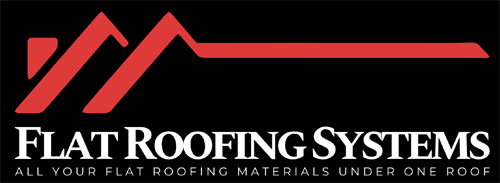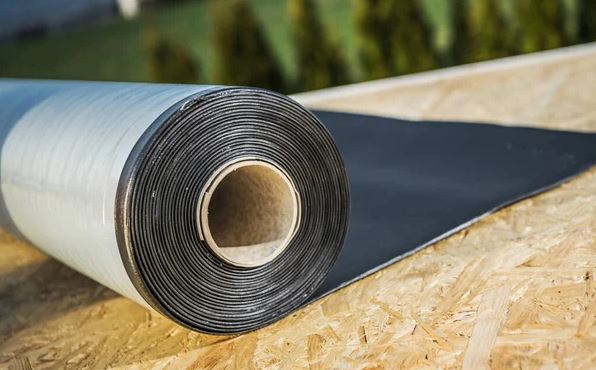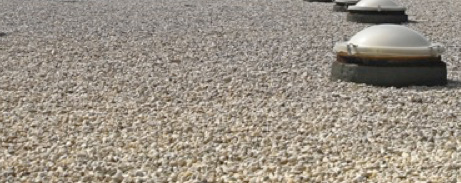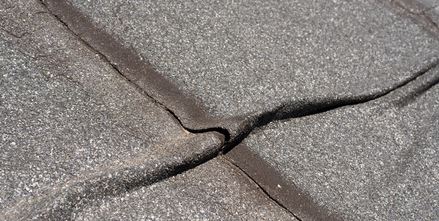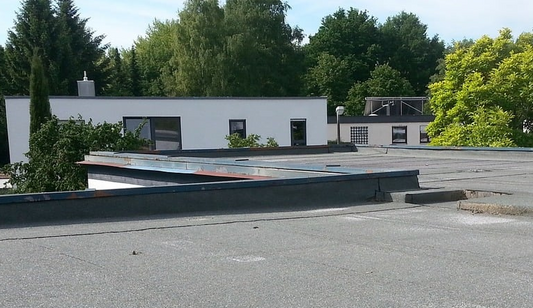EPDM rubber roofing is a popular choice for flat or low-slope roofs due to its durability and versatility. You may be considering how it compares to traditional felt roofing.
EPDM stands out for several reasons. Firstly, its installation process is straightforward and can often be completed more quickly than that of felt roofing, which can lead to reduced labour costs.
Additionally, EPDM is known to last up to 50 years with proper maintenance, and simple actions like regular cleaning and immediate repairs can extend its lifespan even further.
In terms of cost-effectiveness, EPDM is generally more economical in the long run compared to felt because it requires less maintenance and is more durable.
Environmentally, EPDM roofing is also a superior choice as it is typically made from recycled materials and is fully recyclable at the end of its life, reducing landfill waste.
In summary, when comparing EPDM to felt roofing, EPDM not only offers a more robust and cost-effective solution but also benefits the environment. This makes it an excellent option for anyone looking to make a smart, sustainable investment in their property's roofing.
What is EPDM rubber roofing ?
EPDM - short for Ethylene Propylene Diene Monomer - is a synthetic rubber widely used for roofing, especially on flat or low-slope structures.
Developed in the 1960s, EPDM is prized for its exceptional durability and flexibility, which enable it to perform well in various weather conditions. Whether it's intense sun or freezing temperatures, EPDM resists cracking and drying, making it ideal for long-lasting roofing solutions.
One of the key benefits of EPDM roofing is its impressive lifespan of over 50 years.
It's highly resistant to UV rays and provides excellent waterproofing, ensuring that roofs remain leak-free. This type of roofing is also versatile, as it can be installed on different roof decks like OSB and plywood, simplifying the installation process for many buildings.
EPDM isn't only effective but also cost-efficient. It offers substantial performance without a high price tag, making it a smart choice for both new constructions and roof replacements.
This roofing material stands up well against various climatic conditions, providing a reliable and economical option for protecting buildings.
How to install EPDM rubber roofing ?
To install EPDM rubber roofing, start by ensuring the base of your roof is dry and clean. It's important to work in temperatures above 5 degrees Celsius because this helps the adhesive work better.
Begin by rolling out the EPDM membrane on your roof, making sure it lies flat. This might take about 30 minutes as the material needs to settle and smooth out any wrinkles.
Next, choose either water-based or spray adhesives to secure the membrane. Use a roller or brush to apply the glue evenly.
Start at one end of the roof to lay down the membrane, pressing down carefully to avoid trapping air. If any bubbles appear, use a small roller to push them out gently.
If your roof gets a lot of foot traffic, it's wise to add walkway pads for extra durability in those heavily used spots. EPDM can handle some walking, but frequent use without these pads could lead to damage.
Finally, trim any extra material at the edges for a neat finish. Make sure all edges are well-sealed to keep your roof watertight and secure against the elements.
This thorough approach helps ensure your EPDM roofing is installed correctly and lasts for years.
How long does EPDM roofing last ?
EPDM roofing systems are known for their long-lasting durability, often remaining effective for up to 50 years.
This longevity results from the material's resistance to sunlight and overall robustness. For example, EPDM roofs that were installed in the 1970s continue to function effectively today, demonstrating their lasting performance.
It's important to note that the thickness of the EPDM membrane significantly influences its durability. For instance, a 1.14mm thick FlexiProof EPDM membrane, priced at £9.60 + VAT per square meter, provides excellent durability. While this might seem like a considerable upfront cost, the membrane's potential to last over 50 years makes it a cost-effective choice in the long term.
Additionally, EPDM roofing comes with a 20-year material warranty.
With proper installation and regular maintenance, including inspections and effective water management, the lifespan of your roof can surpass this warranty period, offering a great return on investment. This maintenance helps ensure that the roof continues to protect your property efficiently for many years.
What is the best glue for EPDM rubber ?
The best glue to use for EDPM rubber is usually a water-based or contact spray adhesive that's formulated specifically for bonding EPDM membranes to various surfaces. It's important to select a solvent-free adhesive to prevent damage to the EPDM membrane and avoid making it brittle as time passes.
It's essential the adhesive used is suitable for both the EPDM rubber and the surface you're attaching it to. This compatibility helps create a robust and lasting bond.
Key considerations for using EPDM adhesives include the environmental conditions during application. For example, the ideal temperature for applying the adhesive should be no less than +5°C, and the humidity should be below 80%.
Make sure to follow the manufacturer's guidelines precisely when applying the adhesive. This involves preparing the surfaces correctly, applying the adhesive properly, and allowing sufficient time for the adhesive to cure as recommended.
Is EPDM better than felt ?
When deciding between EPDM and felt for roofing, it's crucial to consider their differences and how they might impact your long-term satisfaction and costs.
EPDM, a type of rubber roofing, is known for its impressive lifespan of up to 50 years. In contrast, felt roofing generally lasts only between 10 to 20 years. The reason behind EPDM's longevity is its robustness; it resists environmental factors like UV rays, ozone, and extreme temperature fluctuations very well.
On the other hand, felt is more vulnerable to developing cracks and splits, which can let water seep through and potentially cause substantial damage to your property.
Considering costs, EPDM might appear more expensive initially, but its long life and minimal maintenance requirements often make it a more economical choice over time.
Furthermore, EPDM is environmentally friendly—it can be completely recycled and reused, unlike felt. This aspect not only helps in reducing waste but also supports sustainable building practices.
In summary, if you're looking for a roofing option that's durable, cost-effective over its lifetime, and environmentally friendly, EPDM is a compelling choice compared to felt.
Its ability to withstand harsh weather conditions without frequent repairs or replacements provides peace of mind and long-term savings.
Can you lay EPDM in the rain ?
Installing EPDM roofing during rain isn't advisable.
Rainwater can weaken the glue that bonds EPDM to your roof. If water interferes during installation, the roofing material may not stick properly, leading to issues like lifting or bubbling later on.
Here are clear reasons why waiting for a dry day is crucial:
- Adhesive Issues: Rainwater can weaken the glue that bonds EPDM to your roof. If water interferes during installation, the roofing material may not stick properly, leading to issues like lifting or bubbling later on.
- Moisture Problems: Laying EPDM on a damp surface can trap water between the roofing and the deck. Over time, this moisture might cause mold to grow or even damage the structure of your building.
- Safety Concerns: Roofs are slippery when wet, which makes working on them during rain risky. The risk of slipping and falling increases, which could lead to serious injuries.
- Curing Complications: Some EPDM roofs need time for adhesives and sealants to set. Rain can interrupt this process, compromising the roof's long-term reliability and effectiveness.
For these reasons, it's wise to install your EPDM roof on a day when the weather is clear.
This ensures a stronger bond, reduces safety hazards, and enhances the overall durability of your roofing system.
Waiting for favorable weather not only helps in achieving a better installation but also minimizes risks to your safety.
Can you lay EPDM over felt ?
Installing EPDM membrane over an existing bitumen-based felt roof is possible, but it requires careful preparation.
First, ensure the felt is completely adhered to the roof deck and free from defects such as blisters, cracks, or signs of delamination. These issues can undermine the effectiveness of your new EPDM roofing if not addressed.
Start by conducting a detailed inspection of the felt roof to identify any potential problems.
It's crucial that the felt is fully bonded to the deck to prevent issues like water infiltration or roof failure due to delamination in the future. Once you've assessed the condition of the felt, clean the surface thoroughly to remove any dirt, debris, or moisture.
This step is vital because any contaminants can obstruct the proper adhesion of the EPDM membrane to the felt.
How to clean an EPDM rubber roof ?
To clean an EPDM rubber roof, follow these steps:
1. Use Mild Detergent and Water: Create a mixture of gentle soap and water, and use a soft brush to clean the roof.
This method effectively removes dirt without damaging the rubber membrane.
2. Avoid Harsh Chemicals: Don't use strong chemicals, rough cleaning products, or high-pressure water sprays.
These can harm your roof, potentially leading to expensive repairs.
3. Use Vinegar for Tough Stains: If you encounter stubborn stains or heavy dirt accumulation, mix equal parts of water and white vinegar.
Apply this gently on the stains and rinse well to avoid any leftover residue that might attract more dirt.
4. Clean Regularly: It's beneficial to clean your EPDM roof twice a year or after extreme weather events.
Regular cleaning not only enhances the appearance of your roof but also allows you to identify and address minor issues before they become serious problems.
How to repair damaged EPDM roofing ?
If your EPDM roofing is damaged, it's crucial to fix it quickly to avoid further issues.
Depending on the damage location, use appropriate materials. For tears or holes, use seam tape primer and self-adhesive Flashing Tape. These materials are straightforward to apply and effectively prevent water from seeping through.
For areas like corners or edges, use products designed for these shapes, such as Quickseam SA flashing or Quickseam Corner Flashing patches, to ensure a tight, watertight seal.
Before starting the repair, prepare the surface properly. For an older EPDM membrane, clean the area well, apply a primer, and then place a laminated patch on the spot.
You'll need scissors to cut the patch, a tape measure to check the size, and a solvent-resistant roller to apply the patch securely.
Regular roof inspections are crucial. They help you identify problems early, preventing major repairs later.
Maintain your roof regularly to prolong its life.
Can you lay EPDM over fibreglass roof ?
You can lay EPDM rubber roofing on top of an existing fibreglass roof. This method isn't only straightforward but also cost-effective, eliminating the need for a complete roof overhaul.
However, adhering to specific steps is crucial to ensure that the new EPDM layer performs optimally on the old fibreglass.
1. Inspect the Existing Roof: Firstly, examine the fibreglass roof for any signs of damage or severe wear. It's essential that the surface is stable and in decent condition to support the new layer.
Repair any noticeable cracks or blisters before proceeding.
2. Clean the Surface: Ensure the fibreglass roof is free from dirt, debris, and any oily substances.
A clean surface is critical as it helps the EPDM adhere better, avoiding potential issues with the installation.
3. Apply a Primer: Before laying the EPDM, apply a suitable primer to the fibreglass.
This step is vital as it enhances the bond between the fibreglass and the new rubber sheet. Make sure the primer is evenly applied and allowed to cure completely.
4. Install EPDM: Unroll the EPDM membrane and place it carefully over the primed surface.
Use an appropriate adhesive to secure the EPDM, paying close attention to edges and seams to ensure they're tightly sealed.
This helps prevent any future leaks.
Can you walk on EPDM rubber roofing ?
Yes, you can walk on EPDM rubber roofing, but you should take certain precautions. EPDM is resilient and withstands various weather conditions well, but regular walking can cause damage over time.
When walking on your EPDM roof, it's wise to wear soft-soled shoes to reduce damage.
It's best to walk on areas that have reinforcement or where protective walk pads are placed. These pads help prevent the roofing material from getting scratched or punctured, which is particularly important in areas that see a lot of foot traffic or where frequent maintenance occurs.
Although EPDM is tough, it's not indestructible.
To maintain the roof's condition, try to limit how much you walk on it. When you need to perform maintenance or an inspection, plan a path that avoids unnecessary steps on the roof.
If your roof is accessed often, installing more walkway pads can be a good investment to protect the roofing material.
Can EPDM be painted ?
It's entirely possible to paint EPDM membranes. Here's what you need to know before you start painting:
1. Preparation: Yes, you can paint EPDM, but first, the surface must be clean.
Remove all dirt, debris, and grease because these can stop the paint from sticking properly.
Use a cleaner specifically made for EPDM to prepare the surface.
2. Selecting Paint: You must use paint made for rubber surfaces.
Look for paints that are acrylic or urethane-based as they adhere well to EPDM and can handle weather conditions.
3. How to Apply: For even coverage, apply paint with a roller or sprayer instead of a brush, which can leave marks.
Make sure the weather is dry and not windy when you paint to prevent any issues.
4. Maintenance: After painting, keep up with maintenance to ensure the paint lasts longer.
Annually check for any cracks or peeling and do touch-ups if necessary to keep the coating effective.
Can EPDM be installed in cold weather ?
EPDM can be installed when it's cold, but the success of the installation heavily depends on the temperature and humidity. The adhesive used with EPDM needs to be at least +5°C to work effectively. Also, it's best to keep humidity below 80% to prevent any complications during the installation process.
As temperatures drop, installing EPDM becomes more challenging. The cold can weaken the adhesive's ability to bond properly, which might result in the roof failing prematurely.
If it gets too cold, the adhesive may not set at all, making your roof less secure.
Can EPDM be installed on plywood ?
EPDM roofing is compatible with plywood, making it a practical option for various construction projects.
If you're considering installing EPDM directly on a plywood deck, here's how to do it effectively:
1. Surface Preparation: Ensure the plywood surface is clean, dry, and smooth before installation.
This preparation involves removing any debris or objects that could damage the membrane.
2. Underlayment: To protect both the plywood and the EPDM, use a vapor barrier or another suitable underlayment.
This layer is crucial as it prevents moisture from the plywood from harming the rubber membrane.
3. Adhesive Application: Use an adhesive that's specifically designed for bonding EPDM to plywood.
Apply this adhesive evenly to avoid issues like peeling or blistering later on.
4. Sealing and Finishing: After laying the EPDM, carefully seal all edges and seams.
This is done to block any water from entering. Employ seam tape and a sealant that are formulated for use with EPDM roofs.
How much does EPDM rubber roofing cost ?
If you're planning to install EPDM rubber roofing, the costs can vary depending on several important factors.
For just the materials, prices usually start from £12 per square metre.
The price differences are often due to the thickness of the EPDM membrane and the specific layout of your roof.
The complexity of your roof design will also impact labour costs. Roofs with multiple penetrations or steep slopes generally require more time and expertise to handle, which can raise the installation costs.
Additionally, if removing your old roofing material is necessary, this can add to the overall cost of the project.
Is EPDM fire resistant ?
EPDM exhibits “excellent flame-retardant performances. In addition, flame retardant EPDM significantly decreases the heat and smoke release.
The Flexproof EPDM system that Flat Roofing Systems stocks is fire rated to Broof (t4) fire rating.
Is EPDM recyclable ?
EPDM, commonly used in roofing, isn't recyclable in the traditional sense. However, this doesn't mean it's completely environmentally unfriendly.
EPDM can still be repurposed for various uses once its primary function as a roof has ended. For instance, EPDM can serve as an underlayment for new roofs or as a waterproof barrier for other projects, effectively reducing waste.
Additionally, it can be transformed into materials for playground surfaces or pathways, helping to foster a sustainable environment.
Manufacturers are making strides toward making EPDM recyclable. They're investigating closed-loop recycling systems that could potentially turn old EPDM roofing into new products.
Such advancements could significantly cut down on the use of new materials and the amount of waste that ends up in landfills.
Until these technologies are fully developed, it's important to consider how EPDM's ability to be reused contributes to environmental sustainability.
What are common problems with EPDM roofs ?
Here are some common issues with EPDM roofs to be aware of:
1. Tears and Punctures: These can occur from debris impact or frequent walking on the roof. Such damage compromises the membrane, potentially causing leaks.
It's crucial to repair these promptly to maintain the roof's integrity.
2. Bubbles and Trapped Air: Poor installation can leave air trapped under the EPDM membrane, forming bubbles.
These bubbles may worsen with temperature fluctuations, increasing the risk of leaks. Ensuring a smooth installation with proper tools like rollers can prevent this problem.
3. Cost Misconceptions: EPDM roofs may seem expensive initially compared to other materials like felt.
However, considering their long lifespan and minimal maintenance requirements, they can be more economical over time.
4. Installation Errors: Correct installation is key.
Mistakes like not adhering to the manufacturer's guidelines or using the wrong adhesives can lead to premature roof failure and water damage.
Always ensure proper installation techniques are employed.
To keep your EPDM roof performing well, address these issues swiftly and seek advice from roofing professionals.
This proactive approach will help extend the life of your roof and ensure it continues to protect your building effectively.
